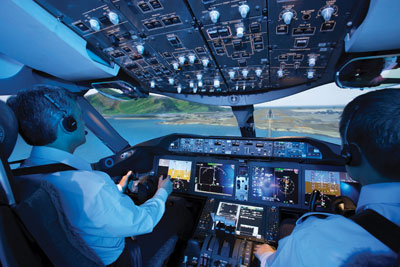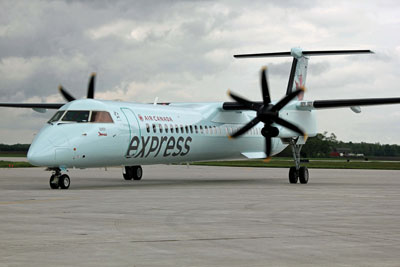
News
The search for supermen and scapegoats
Since the dawn of aviation in 1903, the easiest way to explain accidents has been to blame the pilots – particularly if they are dead.
January 12, 2012 By David Ol
Since the dawn of aviation in 1903, the easiest way to explain accidents has been to blame the pilots – particularly if they are dead. Modern accident investigation techniques have broadened the parameters of cause, but because pilots are the only element common to all accidents, they can never be excluded as a factor – the Human Factor (HF). In 1935, long before HF entered the aviation vocabulary, Rudyard Kipling wrote:
“So when the buckled girder
Lets down the grinding span,
The blame of loss or murder is laid upon the man!
Not on the Stuff – the Man!”
 |
|
| The pilot still remains a critical part of the flying process – and his human behaviour and performance cannot be measured according to the laws of physics and mathematics. PHOTO: CAE |
As writers, psychologists and other experts have reminded us ever since, human behaviour and performance is the one element in aviation, which cannot be measured and specified according to the laws of physics and mathematics. As noted HF expert and pilot David Beaty pointed out, “At the heart of today’s incredibly complex aircraft is a thin-skinned perishable bag of chemicals, fat and 40 litres of water – the pilot!”
Blaming pilots for accidents may induce warm feelings of self-righteousness in others but it is unlikely to identify or solve the root causes. The issues were thrust into the public eye in September 2011 when Maclean’s magazine published a special investigation with the front cover headline “Can your pilot really fly your plane?” Talk about the ideal passenger in-flight reading material! But the magazine was asking the questions that the recovery of the (Air France) AF-447 flight data recorders only weeks earlier, had triggered in many people’s minds. Maclean’s, like many aviation and scientific journals, made the point that while aircraft technology and automation are developing at lightning speed, the training of pilots may actually be being shortened and simplified – particularly since the aircraft are now so “smart” that it is perhaps thought that they can virtually fly themselves. Indeed, in a letter to the Royal Aeronautical Society (RAeS) journal recently, one writer said he had the feeling that the A-380 was a “sort of outsize UAV with the controllers on board.”
Perhaps unintentionally, Maclean’s highlighted the issue that we forget at our peril. Technology and automation are increasing at an exponential rate but the human being who is tasked with flying the aircraft, and even more importantly, making the right decisions almost instantly when things go wrong, is still plodding along in his/her multi-million year evolution. There is a total mismatch between the rate at which we can advance technology, and the evolution of the human brain and its functions.
So, what are we going to do about it? Given the media hullaballoo that greeted the TV premiere of Pan Am recently, some might be tempted to hearken for “the good old days” of suave pilots, nubile stewardesses and “kick the tires and light the fires.” However, examination of the admirable “Summary of Commercial Jet Airplane Accidents 1959-2009” published by Boeing, shows that most of the first generation of jet aircraft had a much higher hull loss/fatality rate than their successors (the MD-11 stands out as a second-generation anomaly). This fact itself may indicate a number of possible but unproven human factors issues, such as the enormous operational changes resulting from the introduction of commercial jet aircraft.
 |
|
| Humans control an aircraft in flight and on the ground – they are responsible for all elements of safety. |
The U.S. Federal Aviation Administration (FAA), the Royal Aeronautical Society (RAeS) and others are very clear about a key HF issue – namely training. Dr. Kathy Abbott, FAA Chief Scientific Adviser for Flight Deck Human Factors, has 30 years experience in the field and is leading the FAA study team on “Operational Use of Flight Path Management Systems.” Preliminary information from the study, expected to be published soon, raises several alarms. One international review of the report material suggests that, “Flight-crew have never been properly trained to operate highly automated aircraft,” and “implies that perhaps they cannot, at present, be effectively trained, because there are no checklists for many of the automation-related problems that pilots frequently encounter. This leaves them having to manage using ingenuity.”
The findings emerging from the study seem to echo what is happening in society generally, as technology makes multigenerational leaps in months. In today’s digital culture, most people are using advanced technology without having a clue as to what is happening or how or why, when buttons are pushed. Pilots are not supermen or superwomen; they are humans like everyone else with all the attendant strengths and weaknesses, but when things go wrong, they all too easily become scapegoats.
The “dirty dozen” of human factors (see, “Contributing Factors,” below), may seem old hat, but they still lie at the heart of what we need to understand when it comes to the demands we make on today’s pilots.
Threat and Error Management (TEM) fits into HF, where threats such as adverse weather and difficult airport conditions trigger pilot responses (which may be affected by the “dirty dozen”) and affect outcomes to different situations. We always come back to the core issue – the pilot is an integral part of the aircraft and its systems and his or her performance affects outcomes in all situations.
In the final analysis, it is humans who control aircraft in flight and are responsible for the safety of all on board. The world’s most important and complex transport system operates in the most unforgiving environment – the air. Do we therefore value those who we take for granted to fly and maintain the aircraft, and do we train them adequately? Studies seem to show that we do not.
The Qantas A-380 incident on Nov. 4, 2010 (QF-32 – Singapore to Sydney) demonstrated both the staggering demands made on crews of modern aircraft in an emergency and the problem of highly automated and complex aircraft, which may not be designed with the humans as an integral part of the operation. There were five pilots on the flight deck when the No. 2 engine exploded at 7,000 feet in the climb. It took all their combined experience and skill – of 71,000 flying hours – to deal with the situation and bring the aircraft safely back to Singapore.
For almost two hours, the crew dealt with an avalanche of warning messages from the aircraft systems. Things could easily have degenerated into chaos, but the crew had the self-discipline and presence of mind to follow the ECAM (Electronic Centralized Aircraft Monitor) and deal with each issue.
Such situations are a conundrum. For the QF-32 passengers, aware that something serious had happened, but powerless to do anything but rely on the judgment and skill of the crew, the desire to be back on the ground must have been overwhelming. Yet, with so much damage to systems other than just a shut-down engine, the crew were in the unenviable position of knowing that an immediate return and landing without a full understanding of the problem might also have been catastrophic. This issue has triggered some debate and no doubt the pilots of Swissair-111 faced the same dilemma when deciding whether to make an immediate overweight emergency landing or dump fuel – and 229 people were killed.
Which brings us back to training. Can we ever fully simulate situations such as SR-111 or QF-32, or indeed AF-447? As Paul Strachan of the Air Canada’s pilots union told Maclean’s, “It almost never happens in real life like it happens in a simulator.”
Training and development bring in all the human factors issues, including how we value pilots and other front-line aviation people. How do we encourage young people to make the commitment that will take them all the way to the left-seat of that A-380, responsible for the lives of perhaps 500 people, or to one of the many other aircraft, large and small, in the civil air fleet?
Not very well from what we see and hear. The FAA study shows that we are not always providing the depth and quality of training for today’s complex aircraft. Then there’s the cost and the reward – which is where, it seems that many dedicated pilots are undervalued by society. To get to the left-hand seat of a commercial aircraft can take $100,000 in training costs, above-average medical fitness, dedication and struggle in spades, frequent medical and proficiency checks and several thousand hours’ experience.
Before reaching that seat, you may earn less than the person driving the crew bus – or worse yet, nothing at all. Pay2Fly schemes have now crept in, where pilots may have to fly 500 hours on type on non-paying contracts. For the same effort and money, one could train to be a doctor and achieve a much higher salary and social status.
The two-part Human Factors series in Wings has not attempted to cover all HF issues – plenty of textbooks and studies do that. Rather, it seeks to stimulate debate, underline the key importance of Human Factors in aviation and encourage regulators and management to value the huge contribution to the aviation industry that is made by certificated aviation professionals in the air and on the ground.
| Contributing factors As noted in the first part of Wings’ two-part series on the role of HF in accidents (“Identifying the problem,” pg. 47, Sept/Oct 2011), here are the Pandora’s Box of human factors (the “dirty dozen”): • Lack of Knowledge |